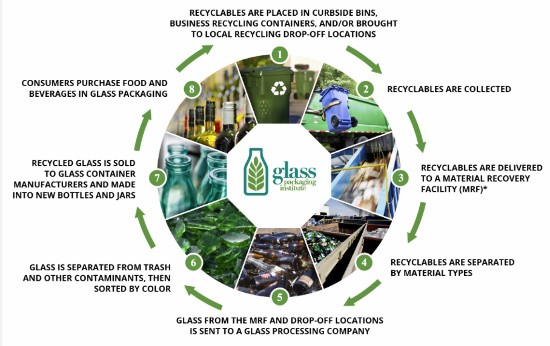When I opened my refrigerator door this morning I noted about a dozen glass jars were inside. The remainder of the containers were either plastic or wax-coated paper composites. In my cupboards, I have made an off-and-on attempt to reuse some of the glass containers I buy. Old soup bottles contain dry storables. But most of the time when I finish the contents of a jar it goes into my recycling bin along with all the single-use plastic, paper and cardboard packaging that goes along with consumer goods purchases today.
What happens to the glass, however, is what I want to talk about today. Why? Because glass, unlike plastic and paper, is infinitely recyclable, never losing its material integrity. Yet most of it continues to be dumped in landfill sites around the world. This is an environmentally unsound practice for a material that when manufactured each year contributes as much as 86 million tons of carbon dioxide to the atmosphere. If we were to reuse the glass, that would mean much less carbon pollution contributing to global warming.
Global production of glass containers and bottles in 2020 reached 690 billion pieces. Forecasted growth has it reaching 922 billion pieces by 2026. The other area where glass is used is for windows. Production here is expected to reach 1.19 billion square metres by 2023.
The primary ingredient of glass is silica sand. The secondary material is soda ash. Glass is made by heating limestone to 1,500 Celsius degrees. Today, most glass manufacturing uses natural gas as the heat source which contributes up to 85% of the industry’s total carbon emissions. The remainder of the emissions come from the byproducts of the chemical reaction among the limestone, ash and silica sand. To remove that 85%, glass manufacturers can switch to renewable electricity sources which would mean the production of glass would be nearly carbon neutral.
When crushed recycled glass is used in the making of new glass, it means less raw material and less heat to produce a final product. Called cullet, the addition of crushed recycled glass further reduces carbon emissions.
Bottle glass and flat glass are different products. Recycled bottle glass cannot be used in the making of flat glass. And because glass is heavier than plastic, using it as a replacement for the latter does add on to transport costs and emissions.
Currently, where is glass manufacturing and recycling being handled best? The European Union is the model to look to for bottled glass. In all 27 member states, there is a concerted effort to recycle. As a result, new glass produced today in the EU contains 52% recycled glass with the Community setting a 90% target by 2030.
Some additional glass facts to consider as a consumer:
- In the United States, container and fibreglass manufacturers purchase 3.35 million tons of recycled glass every year to make new products.
- More than a ton of natural materials and resources are saved for every ton of recycled glass.
- There is a 2-3% drop in energy costs to manufacture new glass products for every 10% of cullet (recycled crushed glass) used in the process.
- Every six tons of recycled container glass used in manufacturing removes one ton of carbon dioxide emissions going into the atmosphere.
The pushback from manufacturers and merchandisers who use one-time-use plastic remains a significant challenge, making it harder for consumers to advocate for increasing environmentally sustainable consumer goods packaging where glass is used more frequently. It’s not that we should eliminate plastic from packaging. It is far too convenient a material. But for bottled products, minimizing single-use plastic by replacing it with glass is environmentally advantageous. Considering the commitments coming out of COP26 to try and keep global atmospheric temperatures from rising beyond a mean 1.5 Celsius degrees, governments have to look at manufacturing materials and consumer packaging where glass can serve as an environmentally sustainable alternative to single-use plastic.








